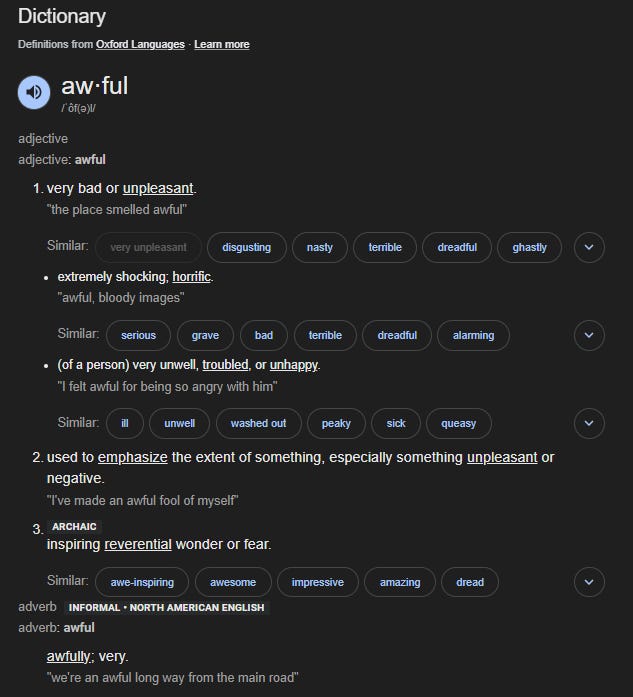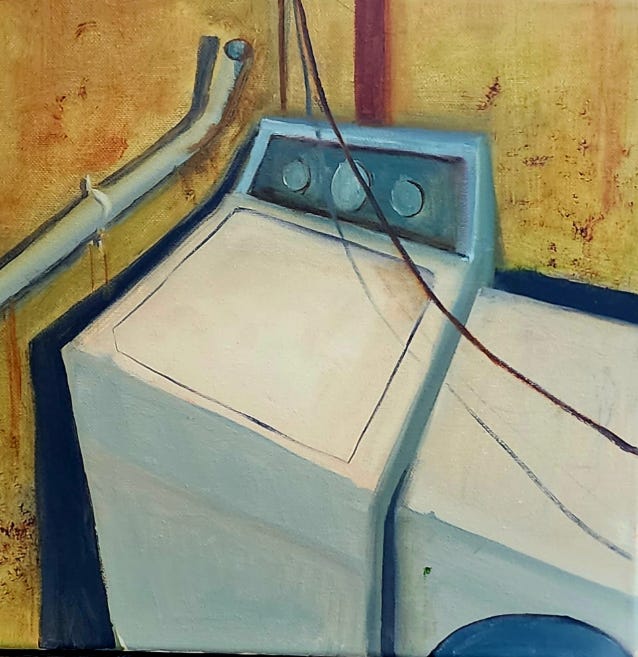I haven’t gotten to the studio nearly as much as I want or need to, which is probably why the existential importance of art in my life has been so heavily on my mind. I’ve said before, and it’s literally in the title of my Substack, that art is the most honest thing I can do. And it is.
There is something incredibly exposing about making art. People see everything: what you’re good at, what you’re not so good at, what you think is important, and what you think doesn’t matter. It starts with the choice of a subject and concludes once you sign and label a painting. Making art is like standing in front of a crowd consisting of both strangers and non-strangers tout nu.
The rawness and genuineness of art is very attractive.
But wait, there’s more
My brain never seems to shut up. I mean shut down. There’s between five to seven conversations going on in my head at once. I don’t mind it - I’m in my forties, I’m used to it. But it does become exhausting. Couple that with being an introvert in a demanding extroverted job, and sometimes I’d really like my brain to just shut down (or up). Yes, there’s meditation, and I do that, but it only ever goes so far in quieting my braintalk.
Making art does a much better job at quieting my buzzing mind. Art is so difficult for me that it forces my brain to shut up (or down) so that it can use all of its resources on the task at hand. It’s so pervasive that, even though I usually work with something on in the background (a podcast, an audio book, a fight, a cricket match) I usually can’t tell you what I was listening to when I’m done.
It’s not pleasant, per se. It’s certainly not meditative in any mindful, peaceful sense. If anything, it’s demanding, compulsive, encompassing, and wonderful. It’s truly an awful experience in both the contemporary and archaic sense of the word. It is the closest thing to understanding what the author of Proverbs meant when he wrote “The fear1 of the Lord is the beginning of knowledge.”
Look, what I’m saying isn’t novel nor is it unique to me. There is a large (and still growing) corpus of experimental (using that term loosely…) research on the effect making art has on the brain, so much so that we even have a name for it: neuroaesthetics.
I am not special
Creating art (be it drawing, painting, ,sculpting, felting, whatever) isn’t just a leisurely pastime; it’s a powerful tool that can alter brain function and structure in beneficial ways. Making art stimulates a complex interplay of a number of brain regions and, ultimately, can improve overall well-being. Thus speaks the literature:
Making art has been shown to be an effective tool for emotional regulation, as it can significantly reduce levels of the stress hormone cortisol, even in people with no prior artistic experience.
Making art often induces a “flow state”, a deeply focused and immersive experience that reduces anxiety and provides a non-verbal outlet for expressing difficult emotions.
Making art promotes neuroplasticity, which is the brain’s ability to reorganize itself by forming new neural connections. This is why art therapy is often used in rehabilitation for conditions like traumatic brain injuries.
Making art enhances problem-solving skills, critical thinking, and fine motor skills by requiring concentration and strategic planning.
These claims are all supported by scholarly books and refereed articles. Here’s just a few:
Your Brain on Art: How the Arts Transform Us by Susan Magsamen and Ivy Ross, which discusses the science of neuroaesthetics and cites studies showing how engaging in the arts can improve both physical and mental health.
“Reduction of Cortisol Levels and Participants’ Responses Following Art Making,” by Girija Kaimal, Kendra Ray, and Juan Muniz and published in the journal Art Therapy, demonstrated that just 45 minutes of creative activity in a studio setting significantly lowered cortisol levels in participants.
“How the arts heal: a review of the neural mechanisms behind the therapeutic effects of creative arts on mental and physical health” by Kelly Sarah Barnett and Fabian Vasiu, reviews the neurobiological mechanisms of art, dance, and music therapies. Throughout the literature, they discerned pretty consonant evidence that creative engagement consistently activates neural circuits involved in emotional regulation.
“Art and brain: insights from neuropsychology, biology and evolution” (2009), by Dahlia W. Zaidel and published in Neuropsychologia, provides an overview of the neural underpinnings of art, discussing how brain-damaged artists have shown that while some abilities may be impaired, artistic skills are often preserved. This might suggest that art-related cognition is not confined to a single brain region but rather involves a widely distributed network.2
Domestic Panic
There’s obviously a connection to my experience and that of art therapy, but it’s not a direct or 1:1 connection. I do not create art to feel better. I create art because I’m an artist. But the perqs are undeniable and wonderful, even if accompanied by pain and frustration3 (or maybe because they are accompanied by pain and frustration).
There was, however, one painting I did that spoke directly to a therapeutic need, and that, after it was complete, soothed me in a way that I imagine art therapy art therapy is designed to do. It’s called “Domestic Panic”, and it still makes me smile. Painting this was a sort of rebellious act, for me, a time when I said “no, we’re not doing this anymore”, and the universe listened.
Please note: As a Blick’s Affiliate and an Amazon Associate I earn from qualifying purchases.
Cf. (all quotes are from the ESV):
Old Testament
The Fear of the Lord as the Beginning of Wisdom and Knowledge:
Proverbs 1:7: “The fear of the LORD is the beginning of knowledge; fools despise wisdom and instruction.”
Proverbs 9:10: “The fear of the LORD is the beginning of wisdom, and the knowledge of the Holy One is insight.”
Psalm 111:10: “The fear of the LORD is the beginning of wisdom; all those who practice it have a good understanding. His praise endures forever!”
Fearing God as the Foundation of a Righteous Life:
Deuteronomy 10:12: “And now, Israel, what does the LORD your God require of you, but to fear the LORD your God, to walk in all his ways, to love him, to serve the LORD your God with all your heart and with all your soul,”
Ecclesiastes 12:13: “The end of the matter; all has been heard. Fear God and keep his commandments, for this is the whole duty of man.”
Proverbs 8:13: “The fear of the LORD is hatred of evil. Pride and arrogance and the way of evil and perverted speech I hate.”
Proverbs 14:27: “The fear of the LORD is a fountain of life, that one may turn away from the snares of death.”
Fearing God as a Source of Blessing and Protection:
Psalm 34:7: “The angel of the LORD encamps around those who fear him, and delivers them.”
Psalm 34:9: “Oh, fear the LORD, you his saints, for those who fear him have no lack!”
Deuteronomy 14:23: “And before the LORD your God, in the place that he will choose, to make his name dwell there, you shall eat the tithe of your grain, of your wine, and of your oil, and the firstborn of your herd and flock, that you may learn to fear the LORD your God always.”
Psalm 147:11: “but the LORD takes pleasure in those who fear him, in those who hope in his steadfast love.”
New Testament
Fearing God and Loving Him:
Luke 1:50: “And his mercy is for those who fear him from generation to generation.”
Hebrews 12:28-29: “Therefore let us be grateful for receiving a kingdom that cannot be shaken, and thus let us offer to God acceptable worship, with reverence and awe, for our God is a consuming fire.”
Fearing God and Obedience:
2 Corinthians 7:1: “Since we have these promises, beloved, let us cleanse ourselves from every defilement of body and spirit, bringing holiness to completion in the fear of God.”
Philippians 2:12: “Therefore, my beloved, as you have always obeyed, so now, not only as in my presence but much more in my absence, work out your own salvation with fear and trembling,”
Ephesians 5:21: “submitting to one another out of reverence for Christ.”
1 Peter 2:17: “Honor everyone. Love the brotherhood. Fear God. Honor the emperor.”
Fearing God’s Power and Judgment:
Matthew 10:28: “And do not fear those who kill the body but cannot kill the soul. Rather fear him who can destroy both soul and body in hell.”
Hebrews 10:31: “It is a fearful thing to fall into the hands of the living God.”
Revelation 14:7: “And he said with a loud voice, ‘Fear God and give him glory, because the hour of his judgment has come, and worship him who made heaven and earth, the sea and the springs of water.’”
Kaimal, G., Ray, K., & Muniz, J. (2016). Reduction of cortisol levels and participants’ responses following art making. Art Therapy: Journal of the American Art Therapy Association, 33(2), 74-80.
Magsamen, S. & Ross, I. (2024). Your brain on art: How the arts transform us. Penguin Random House.
Zaidel, D. W. (2010). Art and brain: Insights from neuropsychology, biology and evolution. Journal of Anatomy, 216(2), 177-183.
Bennett, K. S. & Vasiu, F. (2024). How the arts heal: a review of the neural mechanisms behind the therapeutic effects of creative arts on mental and physical health. Frontiers in Behavioral Neuroscience, 18.
I think I’ve heard my wife say this about our marriage.






Well, the "Malcolm in the Middle" clip certainly resonated!